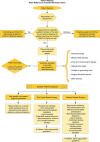Building a Multidisciplinary Academic Surgical Gender-affirmation Program: Lessons Learned
- PMID: 33968551
- PMCID: PMC8099415
- DOI: 10.1097/GOX.0000000000003478
Building a Multidisciplinary Academic Surgical Gender-affirmation Program: Lessons Learned
Abstract
Background: Every day, we see more patients present to hospitals and clinics seeking gender-affirmation care to ameliorate the symptoms of gender dysphoria. However, to provide a multidisciplinary approach, it is important to offer an integrated clinical program that provides mental health assessment, endocrine therapy, physical therapy, research, and the full spectrum of surgical services devoted to transgender patients. This article describes our experience on building a specialized, multidisciplinary, academic state-of-the-art gender-affirmation program.
Methods: Herein, we describe the main and critical components on how to build a multidisciplinary academic gender-affirmation program. We share our lessons learned from this experience and describe how to overcome some of the obstacles during the process.
Results: Building a multidisciplinary academic gender-affirmation program requires an invested team, as each and every member is essential for feedback, referrals, and to improve patient's experience. Institutional support is essential and by far the most important component to overcome some of the obstacles during the process. Having all team members working under the same institution provides all the critical components needed to improve outcomes and patient satisfaction. In addition, the collection of prospective data with a well-structured research team will provide information needed to improve clinical services and standardize clinical protocols, while leaving space for innovation.
Conclusions: This article describes the steps and experience needed to build a multidisciplinary holistic academic gender-affirmation program. We provide our lessons learned during the process that will help guide those who intend to start an academic gender-affirmation program.
Copyright © 2021 The Authors. Published by Wolters Kluwer Health, Inc. on behalf of The American Society of Plastic Surgeons.
Conflict of interest statement
Disclosure: The authors have no financial interest to declare in relation to the content of this article.
Figures
Similar articles
-
Building a Multidisciplinary Comprehensive Academic Lymphedema Program.Plast Reconstr Surg Glob Open. 2020 Mar 20;8(3):e2670. doi: 10.1097/GOX.0000000000002670. eCollection 2020 Mar. Plast Reconstr Surg Glob Open. 2020. PMID: 32537334 Free PMC article.
-
A Single Center Case Series of Gender-Affirming Surgeries and the Evolution of a Specialty Anesthesia Team.J Clin Med. 2022 Mar 31;11(7):1943. doi: 10.3390/jcm11071943. J Clin Med. 2022. PMID: 35407551 Free PMC article.
-
Critical Care Network in the State of Qatar.Qatar Med J. 2019 Nov 7;2019(2):2. doi: 10.5339/qmj.2019.qccc.2. eCollection 2019. Qatar Med J. 2019. PMID: 31763205 Free PMC article.
-
Gender Affirmation Surgery: A Primer on Imaging Correlates for the Radiologist.AJR Am J Roentgenol. 2019 Dec;213(6):1194-1203. doi: 10.2214/AJR.19.21686. Epub 2019 Aug 15. AJR Am J Roentgenol. 2019. PMID: 31414889 Review.
-
An Updated Overview of Gender Dysphoria and Gender Affirmation Surgery: What Every Plastic Surgeon Should Know.World J Surg. 2021 Dec;45(12):3511-3521. doi: 10.1007/s00268-021-06084-6. Epub 2021 Apr 1. World J Surg. 2021. PMID: 33796924 Review.
Cited by
-
Which Is the Best Surgical Approach for Female-to-Male Sexual Reassignment? A Systematic Review of Hysterectomy and Salpingo-Oophorectomy Options from the Gynecological Perspective.Medicina (Kaunas). 2024 Jul 4;60(7):1095. doi: 10.3390/medicina60071095. Medicina (Kaunas). 2024. PMID: 39064524 Free PMC article.
References
-
- Coleman E, Bockting W, Botzer M, et al. . Standards of Care for the health of transsexual, transgender, and gender-nonconforming people, version 7. Int. J. Transgender Health. 2012; 13:165–232
-
- Turban J. What is gender dysphoria?. American Psychiatric Association website. 2020. Available at: https://www.psychiatry.org/patients-families/gender-dysphoria/what-is-ge.... Accessed November 15, 2020
-
- Schechter LS. Background. Surgical Management of the Transgender Patient. 2016, Philadelphia, Pa: Elsevier; 3–7. In Schecter LS (ed.)
-
- Safer JD, Tangpricha V. Care of transgender persons. N Engl J Med. 2019; 381:2451–2460 - PubMed
LinkOut - more resources
Full Text Sources
Other Literature Sources


